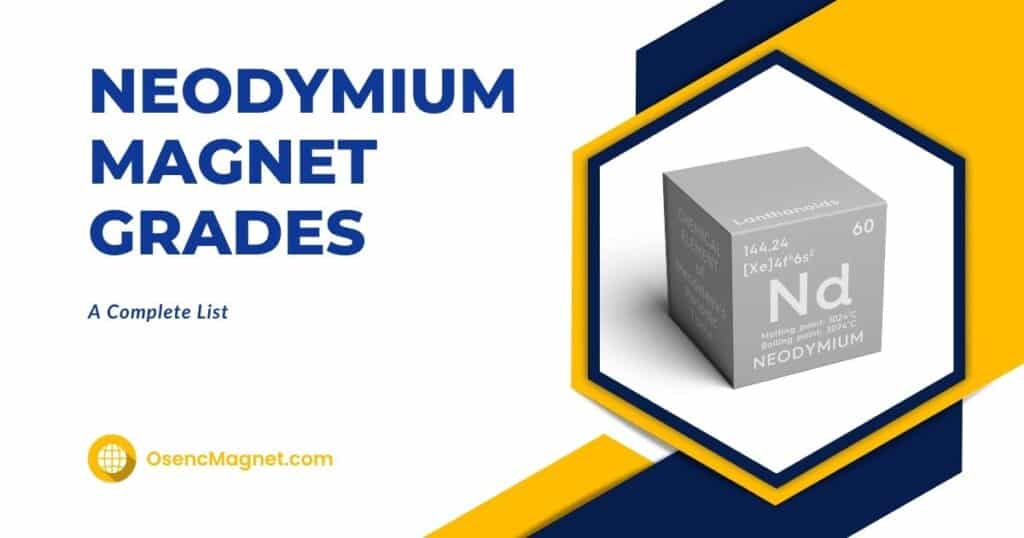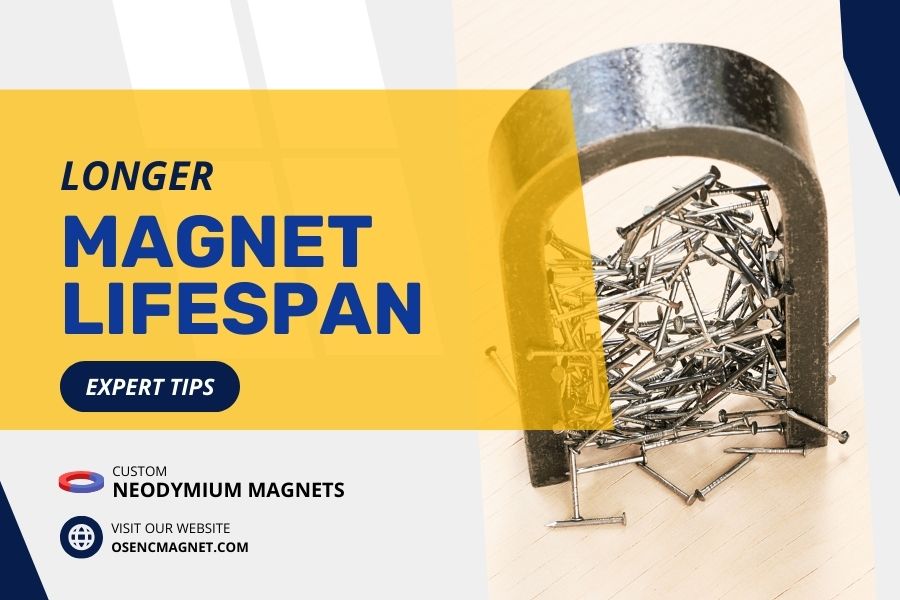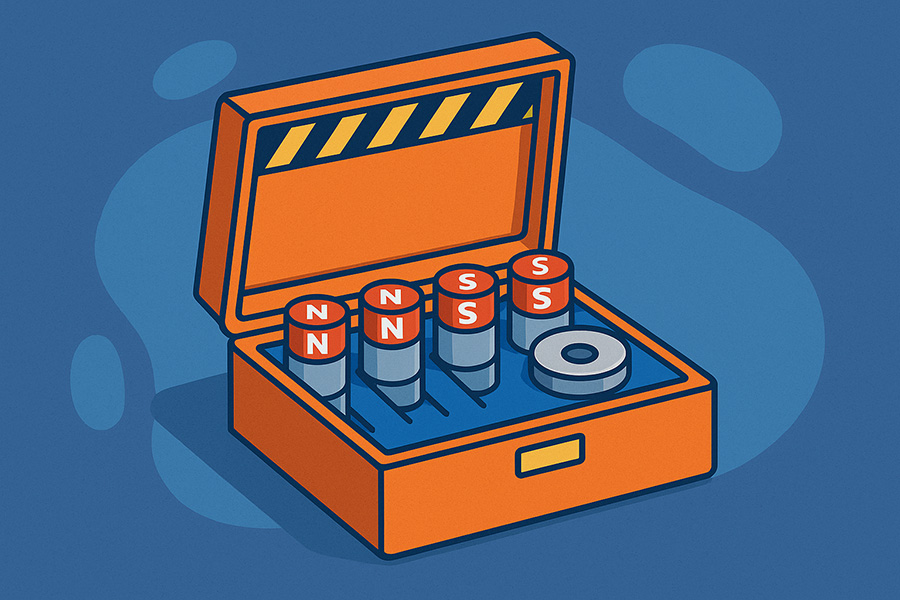Not sure about neodymium magnet grade codes like N35 or N42SH?
Don’t worry – you’re not alone.
The grading system seems tricky at first, but this post will break it down for you in simple terms.
Table of Contents
What Are Neodymium Magnets?
Neodymium magnets are the strongest permanent magnets you can buy.
They’re made mostly of neodymium, iron, and boron in the Nd₂Fe₁₄B crystalline structure.
- A typical one contains about 29-32% neodymium, 64-68% iron, and 1% boron, plus small amounts of other elements like dysprosium and praseodymium to boost performance.
These magnets are hard and brittle.
Manufacturers make them through a powder metallurgy process called sintering, where they compress and heat metal powder without melting it.
This creates incredibly strong magnets, but also makes them quite fragile.
What Do Those Grade Numbers Mean?
All neodymium magnets start with “N” for “Neo.” The number after tells you how strong the magnet is.
The Strength Numbers
The number after “N” shows the maximum energy product in MGOe (megagauss-oersteds).
Higher numbers mean stronger magnets.
For example:
- N35 has around 35 MGOe
- N52 has about 50 MGOe
Common grades you’ll see include:
- N30 – Energy product between 28-31 MGOe (Br: 10.8-11.4 kG)
- N35 – Energy product between 33-36 MGOe (Br: 11.7-12.2 kG)
- N38 – Energy product between 35-39 MGOe (Br: 12.2-12.6 kG)
- N40 – Energy product between 38-41 MGOe (Br: 12.6-12.9 kG)
- N42 – Energy product between 40-43 MGOe (Br: 12.9-13.3 kG)
- N45 – Energy product between 43-46 MGOe (Br: 13.3-13.7 kG)
- N48 – Energy product between 46-49 MGOe (Br: 13.7-14.1 kG)
- N50 – Energy product between 48-51 MGOe (Br: 14.0-14.5 kG)
- N52 – Energy product between 50-53 MGOe (Br: 14.2-14.8 kG)
- N55 – Energy product between 52-56 MGOe (Br: 14.6-15.0 kG)
Put simply:
- higher number = stronger pull force in the same size magnet.
Temperature Ratings: Why Those Extra Letters Matter
Ever noticed letters like “H” or “SH” after the grade number? These tell you how heat-resistant the magnet is. All neodymium magnets lose some strength when heated, but better temperature-rated magnets can handle more heat before they’re permanently damaged.
There are two ways heat affects these magnets:
- Temporary loss: All neodymium magnets temporarily lose about 0.11% strength per 1°C temperature increase. This comes back when the magnet cools down.
- Permanent damage: If you heat them past their max operating temperature, they’ll suffer permanent loss of magnetic properties.
Here’s what those letter codes mean:
- Standard (No Letter): Works up to 80°C (176°F). Perfect for regular indoor use. Has an intrinsic coercivity (Hci) of 12.0-18.0 kOe.
- M (Medium): Works up to 100°C (212°F). Good for moderate heat. Has an Hci of 14.0-20.0 kOe.
- H (High): Works up to 120°C (248°F). Handles higher temperatures. Has an Hci of 17.0-25.0 kOe.
- SH (Super High): Works up to 150°C (302°F). Made for super high heat. Has an Hci of 20.0-28.0 kOe.
- UH (Ultra High): Works up to 180°C (356°F). For ultra high temperature needs. Has an Hci of 25.0-32.0 kOe.
- EH (Extra High): Works up to 200°C (392°F). Built for extreme heat. Has an Hci of 30.0-36.0 kOe.
- AH (Advanced High): Works up to 220°C (446°F). For the most intense heat applications. Has an Hci of 35.0-42.0 kOe.
Manufacturers add elements like dysprosium to make higher temperature-rated magnets.
This increases heat resistance but slightly reduces maximum strength.
Choosing the Right Grade for Your Project
Finding the perfect neodymium magnet grade depends on what you need:
Key Factors to Consider
- Strength Needed: Do you need maximum holding power or just moderate strength?
- Temperature Environment: Will the magnet get hot?
- Size Limits: Sometimes a stronger grade lets you use a smaller magnet
- Budget: Higher grades cost more
Common Uses by Grade
- N30-N35: Fridge magnets, crafts, simple closures
- N38-N42: Cabinet latches, magnetic tool holders, medium-duty applications
- N45-N48: Motors, generators, specialized industrial uses
- N50-N55: High-performance applications, precision instruments, where space is tight
Worth noting: The strongest grades (N50-N55) only come in standard or M temperature classes.
This happens because pushing for maximum strength naturally reduces temperature capability.
The highest temperature grades (EH, AH) typically max out around N38-N45 in strength.
Temperature Examples
- Standard (N42): Perfect for indoor use at room temperature
- H-rated (N42H): Good for engine compartments or outdoor applications
- SH/UH-rated (N42SH/UH): Ideal for industrial machinery or near heat sources
Comparing Neodymium to Other Magnet Types
Understanding how neodymium stacks up against other magnets helps you make better choices:
Neodymium (NdFeB) offers the highest magnetic strength (28-56 MGOe) but has limited heat resistance and poor corrosion resistance. The Curie temperature (where magnetism completely disappears) is around 310-340°C, but practical use is much lower.
Samarium Cobalt (SmCo) has good strength (16-32 MGOe) with excellent heat stability (up to 300°C) and corrosion resistance, but costs more than neodymium. SmCo has a much lower reversible temperature coefficient (around -0.03%/°C) compared to neodymium’s -0.11%/°C, meaning its strength changes very little with temperature changes. Its Curie temperature is impressively high at 700-800°C.
Alnico has moderate strength (1-10 MGOe) with excellent heat stability (up to 525°C) and good corrosion resistance. Alnico has the lowest temperature coefficient of any magnet material, with nearly zero change in a closed circuit. Its Curie temperature is about 800°C, but it can demagnetize easily if exposed to opposing magnetic fields due to low coercivity.
Ferrite (Ceramic) has the lowest strength (3-5 MGOe) but is very cheap, completely corrosion-proof, and works well up to 250°C. Ferrite magnets are already oxidized, so they cannot rust further. Their Curie temperature is around 450°C.
Cost vs. Performance: Getting the Best Value
Higher grades cost more money. Is the extra strength worth it?
- The price jump between close grades (like N40 to N42) is usually about 3-5%.
- The strength increase is roughly similar.
When comparing wider gaps (N35 vs N52), the price difference becomes more significant.
For most projects, mid-range grades like N40-N42 offer the best balance of performance and cost. The high-temperature variants (with suffixes like H, SH, UH) will cost more due to the addition of expensive elements like dysprosium.
One big advantage of higher-grade magnets is size reduction.
- Since an N52 magnet is about 50% stronger than an N35 magnet, you can use a much smaller N52 magnet to get the same pull force.
This size reduction can be critical in tight spaces or where weight matters.
Value comparison among different magnet types:
- Ferrite magnets are the most cost-effective but need to be larger
- Neodymium offers the best performance-per-dollar when high strength is needed
- SmCo costs the most but makes sense when high temperature or corrosion resistance is required
Making Your Final Decision
When selecting your neodymium magnet grade:
- Determine the minimum strength needed for your application
- Consider the operating temperature environment
- Factor in size restrictions
- Balance performance with your budget
- Consider corrosion protection needs
The perfect grade isn’t always the strongest or most heat-resistant. It’s the one that meets your specific needs at the right price point.
Understanding Key Magnetic Properties
For those needing more technical information, here are the key properties to understand:
- Remanence (Br): Measured in kiloGauss (kG) or Tesla (T), this indicates the magnetic flux density that remains in the magnet after magnetization (1 kG = 0.1 T). Higher values mean stronger magnets.
- Coercivity (Hc): Measured in kiloOersted (kOe), this is the magnetic field needed to demagnetize the material. Higher values mean the magnet better resists demagnetization.
- Intrinsic Coercivity (Hci): Also measured in kOe, this represents the material’s resistance to demagnetization. Higher-temperature rated magnets have higher Hci values.
- Maximum Energy Product (BHmax): Measured in MGOe, this is the maximum magnetic energy density. It’s the key measure of a magnet’s strength.
Final Thoughts
Understanding neodymium magnet grades helps you make smarter buying decisions.
The grading system might seem complex, but it’s simply a way to classify strength and heat resistance.
Still have questions about which grade is right for your project?
Contact our magnet specialists for personalized recommendations.



